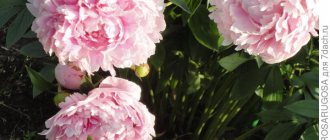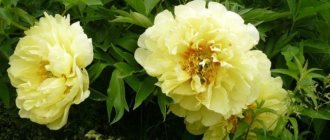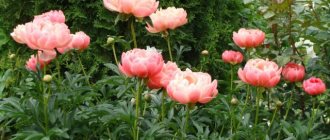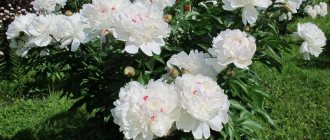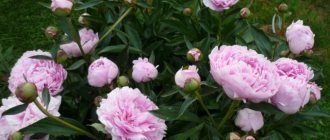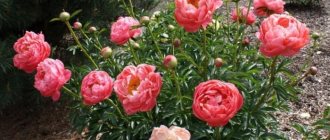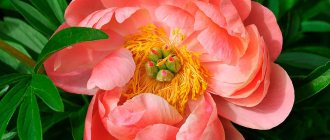The tree peony has incredible beauty and the power to fascinate others. Its delicate petals contain the perfection that only nature can create. Peony is one of the most ancient plants on earth, glorified in legends and endowed with magical properties. In Ancient Greece they believed that peony was able to protect people from evil spirits, and in China this flower became the favorite of the emperor and the nobility. It was the Chinese who began to actively develop new varieties of tree peonies, which gradually began to gain popularity in different parts of the world. All of them amaze with their extraordinary beauty and richness of shades, symbolizing pure love and prosperity.
In modern gardening there are a huge number of varieties of tree peonies.
What is and what does a tree peony look like?
The height of the tree peony (photo of the bush) usually reaches from 1.5 to 2 meters. Dense stems are directed vertically and covered with light brown bark. With age they become thicker and stronger. The stems are decorated with unusually shaped feathery leaves that resemble lacy green lace. On the outside, the leaf plate is painted in a rich green tint, and on the reverse side the surface acquires an original purple tint.
Tree peony is a fairly powerful deciduous shrub.
At the tops of the shoots, buds are formed, which over time turn into large double or semi-double flowers (with a diameter of 12 to 20 cm). Thin, soft petals are painted in the most incredible shades. Here are various tones of purple, pink, red, yellow. Two-tone specimens with iridescent gradient coloring look especially impressive.
Attention! The older the bush, the more buds ripen on it.
With proper care, up to 70 lush flowers bloom on one adult plant. Each of them pleases with its beauty for 14-21 days. Afterwards, star-shaped fruits appear on the bush, which can be eaten. Together with roots and buds, they are used in folk medicine. Delicious teas, tinctures, wine, jam and cosmetics are prepared from the petals.
What is the difference between a tree peony and a regular one?
You can first distinguish a tree peony from a regular one by its appearance. The herbaceous species is a traditional garden flower with thinner and more graceful stems. For the tree-like variety, the name speaks for itself - it is a full-fledged, rather tall and spreading shrub with strong branches. Another feature of it is its resistance to cold. With the arrival of autumn, the foliage completely falls off, and the shoots continue to grow and get stronger, so that in the spring the plant becomes even more luxurious and strong. Herbaceous specimens do not tolerate cold weather at all, and their stems die at low temperatures.
The tree peony bush can withstand an abundance of large flowers
There are also differences in flowering. The tree peony blooms no earlier than 4 years from the moment of planting, or even later. For its grassy relative, this period does not exceed 1 year. The first buds of the tree peony are not cut off, as they do not inhibit the further development of leaves and shoots. This powerful giant is a true long-liver and is able to actively grow and develop in one place for 50 years, without replanting.
Read more Herbaceous peony variety Solange (Solange): planting and care
Seeds
This is the most labor-intensive and ineffective option, which is practically not used by gardeners. Even under favorable conditions, it takes about 5 years from the time the seeds are sown until the flowers appear.
This duration of the process is explained primarily by the specific structure of peony seeds, covered with a very dense shell. The first shoots appear only after a year. To speed up germination, a scarification procedure is carried out, i.e. filing the shell. However, this requires considerable experience, otherwise you may simply damage the seed.
Then the seeds are planted in a prepared container with loose and fertile soil to a depth of 2-3 cm, watered and put away in a warm and bright place. The soil is systematically moistened with a spray bottle until the first shoots appear.
There is a way to accelerate seed germination without scarification. To do this, seeds are planted in small containers in the fall and exposed to frost until spring. In March they are brought indoors. Due to sharp temperature fluctuations (extreme conditions), seeds germinate faster.
In summer, sprouts are cared for like other garden crops, i.e. Periodically water and fertilize. Planting in open ground is also an unpredictable process, because... Each sprout develops individually. Ready shoots are transplanted from containers in the fall.
Only in the third year do such specimens begin to develop full-fledged foliage, and after another two years they will bloom.
Types of tree peonies
In China, all varieties of peonies are divided into many groups based on the names of the provinces in which they were bred. In world practice, a different classification has been adopted. It includes three large groups:
- Sino-European. This includes varieties with large flowers that consist of large petals. They can be in completely different shades: from light pink to rich fuchsia. The too large size of the buds causes admiration, but at the same time they quickly droop and no longer look so beautiful.
Tree peonies of the Chinese-European group are distinguished by large flowers - Japanese. Local breeders have developed original varieties with aerial flowers slightly smaller than those of the representatives of the Chinese group.
In their shape, the flowers of the Japanese group of peonies are similar to a bowl and are semi-double - Hybrids. The ancestor of all these varieties was the Delaway peony, which was crossed with one of the yellow species. Representatives of this group are particularly beautiful, as they subtly combine different shades.
Hybrid groups of tree peonies are distinguished by their unusual petal shapes
The best varieties of tree peonies
Every year more and more hybrid peonies appear. Each new variety amazes with its brightness, splendor and incredible aroma. But among the thousands of varieties, there are those that gardeners love more than others.
Coral Altar (Shan hu tai)
These rich neon pink flowers have quickly become gardeners' favorites. Tall bushes (about 1.5 m) are decorated with beautiful flowers with thin petals of an original shape. They exude a pleasant, sweetish aroma, reminiscent of delicate, expensive perfume. The bushes are very resistant to various pests and diseases, have no special requirements for soil composition, but for active flowering they need a lot of sunlight.
The red altar is distinguished by its rich color and spherical shape of the buds
Green Jade
A delightful, exotic peony with lime-colored petals. Spectacular bushes have strong stems with strong bark. The variety is fast-growing; it needs hot summers and cold winters, so that there is a contrast in temperatures and a clear change of seasons.
Green Jade has an unusual color and light aroma
The Qiao Sisters (Hua er qiao)
Another unique variety that combines two completely different shades: rich purple petals interspersed with a hint of pink lace. One flower has a diameter of up to 16 cm and can have a different number of petals of one tone or another. This variety is light-loving, grows well in alkaline soil and takes root in different climatic conditions. Bushes with two-color buds are rarely affected by any diseases and do not require special care.
One bud of Sister Kiao contains petals of both rich and very delicate shades
Diseases, pests and ways to combat them
The main parasite of peonies is fungi that grow near the roots on the trunks. They must be removed, otherwise the parasites will cause the death of the crop.
Common diseases of shrubs:
- fungal infections;
- gray rot;
- viral diseases.
When signs of disease appear, peonies are treated with a weak solution of potassium permanganate or fungicides. Plants that are not properly cared for are more often affected. Compliance with the rules will help prevent the occurrence of pathologies.
The enemies of the bush include field mice that gnaw its roots. To prevent their attacks, plants are planted in a special net.
The tree peony can decorate any garden plot. At the same time, the plant does not require special conditions for growth and has a simple care regimen. For timely and lush flowering, it is necessary to water the flower in a timely manner, feed it with nutrient mixtures and carry out prevention against pests and diseases.
Winter-hardy varieties of tree peonies
Winter-hardy varieties of tree peonies are in demand in the Siberian and Far Eastern regions. This is due to good resistance to soil freezing (up to half a meter) and intensive growth (more than 20 centimeters per season).
Winter-hardy varieties do not differ in flowering time
White Phoenix (Feng Dan Bai)
Milky petals with a faint pink tint and golden stamens contrast favorably with the unusually shaped leaves of a deep green hue. The flowering period lasts about two weeks.
More details Tree peony: cultivation and care, when to replant, photos, videos
White Phoenix, even after flowering, does not lose its attractiveness due to the interesting shape of the leaf plates
Spring Willow Chun Liu
Every gardener dreams of having such a variety in his collection. The flower simultaneously combines several shades: light green with a transition to pale yellow, and crimson splashes appear at the very base.
Chan Liu flowers have fairly dense buds and look fresh in spring
Red Wiz Pink (Red With Pink)
Incredibly beautiful bicolor with unusual buds. These colors alternate with each other in broad strokes, as if left by the artist’s hand. Each flower resembles a bowl made of the finest porcelain, painted by a reverent master. The plant is famous for its unpretentiousness and ability to withstand extremely low temperatures (from -30 °C or more).
Red Whis Pink has wavy edges and vibrant petals in cherry and pink tones.
Soil preparation and planting
Proper planting is the key to successful growth and longevity of the tree peony. At the same time, a number of requirements are imposed on the soil. She must be:
- fertile (preferably loam);
- with a neutral or slightly alkaline reaction (pH level – 6.0-7.0);
- loose;
- permeable;
- with good breathability.
Clay and sandy soils are not recommended for this variety.
Before planting a peony, the seedling must be inspected. In this case, its root system can be open or closed with an earthen lump. In the first case, it is checked for rot and damage. If necessary, they are removed, and the cut area is sprinkled with charcoal. In addition, it is recommended to soak it in the root formation stimulator “Heteroauxin”, “Kornevin” or “KorneStim” 20-30 minutes before planting.
When the roots are closed, its above-ground part is inspected, which should be healthy in appearance, and the soil should be free of signs of mold and waterlogging.
The sequence of work when planting a plant in open ground:
- Digging a hole a few days before the start of the main process. Dimensions requirements: depth 60-70 cm, diameter 60-80 cm (2-3 times the size of the roots).
- Laying out a drainage layer 20-25 cm high from available materials: expanded clay, gravel, broken bricks and others.
- Soil improvement (if necessary). Dolomite flour, fluff lime, a mixture of sand and ash, and peat are added to the clay soil. In this way, the acidity of the soil is reduced and its breathability is increased. Humus, peat, turf soil and clay are added to sandy soil in equal proportions.
- Adding mineral and organic fertilizers to the hole: superphosphate (30-40 g), potassium sulfate (15-20 g), bone meal (0.5 l).
- Sprinkle the nutrient layer with prepared soil so that in the future there will be no direct contact of the roots with it.
- Water the hole with water at room temperature (until all the liquid is gone).
- Place the seedling in the hole, straightening its roots.
- Sprinkling the plant with soil and compacting it.
Important! The root collar and renewal buds should be slightly below ground level.
- Abundant watering of the bush. This is done carefully so as not to expose the upper part of the root. If necessary, add soil (hilling up).
- Organization of a mulch layer (compost, humus, sawdust, tree bark, etc.).
When planting several crops, leave a distance of at least 1.5 m between them, since the plant is actively growing in width.
Varieties of yellow tree peonies
Yellow tree peonies appeared relatively recently. For a long time, breeders were unable to achieve stable varietal color.
Yellow tree peonies do well in loamy soils.
Sunrise
A popular American hybrid with an almond butter shade and a very fine border around the edges. It gives the flower visual splendor, making it look like an airy marshmallow. Each petal curves gracefully.
Tree peony Sunrise has a beautiful center with rich yellow stamens
Kinko (Jin ge)
It amazes with an amazing fusion of warm, summer tones: creamy color turns into pumpkin, and in some places additional pink tints appear. The petals are so delicate and transparent that they appear to be painted in watercolor. Massive flowers hang slightly from the stems, bending under their own weight.
The Kinko tree peony has massive spherical flowers.
Kuinji
A rich yellow variety, as if dozens of small, gentle suns suddenly blossomed on one bush. On the outer surface of the petals at the very base there are noticeable spots of almost black color. This variety is afraid of waterlogging of the soil.
Cup-shaped Kuindzhi flowers bloom relatively late, but very quickly
Academician Sadovnichy
An amazingly beautiful variety of peonies, the petals of which have a yellow-peach tint adjacent to a rich purple spot at the base. Semi-double cup-shaped flowers immediately attract everyone's attention with their special radiance and grace.
The Academician Sadovnichy flower is distinguished by large petals with jagged edges
Varieties of purple and lilac tree peonies
This unusual color invariably attracts attention. Large flowers are arranged in a cluster and look impressive. Such plants are the highlight of any garden.
Purple and lilac tree peonies have an unusual color and large buds.
Imperial crown
Flowers of the Imperial Crown variety really resemble the crown of a monarch in shape. Cardinal-colored petals with a purple tint are raised upward, and the stamens appear to be covered with thin gold. In the sun they shimmer with hundreds of luminous sparks, like jewels. The key to generous flowering will be reliable shelter in the cold and proper care in the hot season.
Imperial Crown - a spectacular variety with large flowers
Deep Blue Sea (Da Zong Zi)
The flowers of peonies of this variety are painted in raspberry-coral shades and against the background of lush, carved foliage they seem even more voluminous. Each petal is a small perfection captured in a unique form. Even after flowering, the bush remains attractive.
The deep blue sea pleases the eye until the first autumn frosts
Purple Ocean (Zi Hai Yin Bo)
This incredibly large flower blends deep purple and plum colors together. White strokes are applied to the petals as if with the thinnest mascara brush. Against the background of the overall gouache coloring, they look very gentle and make the flower look fatal and at the same time vulnerable and defenseless.
Read more Feeding peonies in the fall and preparing for winter
Tree peony Purple Ocean has an exquisite spicy-fruity aroma
Varieties of pink and red tree peonies
The peculiarity of pink and red peonies is that each variety has an individual shade, unlike the others. The most delicate color and pleasant aroma have made them popular in all corners of the world.
Flowers of pink and red tree peonies have wide, rounded petals
Lantian Jay
An unusually beautiful chalk pink peony with many wavy petals. The flowering process begins at the very beginning of summer, and the garden is filled with a sweet, subtle aroma.
Lantian Jay is shaped like a beautiful pompom
Shima Nishiki (Shima-nishiki – Dao Jin)
An amazing creation of Japanese breeders. This variety appeared due to a natural mutation of the Tayo peony. As a result, the world saw a real masterpiece, consisting of almost white petals generously colored with cinnabar. Stripes and strokes of different widths intertwine with each other, forming natural patterns. In addition to the variegated one, this variety also has a completely monochromatic variety, which amazes with its rich red hue.
Shima Nishiki has about two dozen buds on a young bush
Rose powder (Fen he piao jiang)
Breeders managed to reproduce the shade of a delicate pink pearl, which shimmers, changing the depth of tone. The fragile beauty of this peony makes the heart skip a beat, and its ease of care makes this variety the most desirable among gardeners around the world.
Tree peony Pink powder feels good in Russian latitudes
Top dressing
The tree peony, like other flowering ornamental shrubs, requires regular feeding at all phases of the growing season. At the beginning, it is recommended to apply fertilizers with a predominance of nitrogen, and in the second half - potassium and phosphorus. It should be remembered that an excess of nitrogen contributes to the development of gray rot.
Important! For tree peonies, fertilizing with wood ash, bone or fish meal is very useful. They contain calcium, potassium and phosphorus, which are necessary for the normal development of the plant and increasing its winter hardiness.
The optimal feeding option is five times per season during the following periods:
- The beginning of the appearance of young reddish shoots. It is recommended to use a solution of urea or ammonium nitrate in the following proportion: 1 tbsp. spoon for 10 liters of water (for each bush). Afterwards, it is advisable to organize a layer of humus mulch.
- Bud formation. A dry mixture of ammonium nitrate (1/2 tablespoon), superphosphate (1/2 tablespoon), potassium sulfate (1/3 tablespoon) is scattered under the bush and embedded in the soil.
- Active peony flowering. It is possible to repeat the previous feeding or use wood ash (1-2 cups per bush).
- Completion of flowering (after 2 weeks) . Adding a dry mixture of superphosphate (1 tablespoon) and potassium sulfate (1 tablespoon) under the bush.
- Late autumn (before wintering) . Under each bush, 300 g of wood ash and 200 g of bone meal are added and lightly embedded in the soil.
Important! In order not to cause harm to the root system when applying mineral mixtures, the soil should be watered abundantly before doing so.
For young individuals (up to 3 years), foliar feeding is preferable. In this case, the bushes are sprayed with a solution consisting of: 30 g of mineral fertilizers per 10 liters of water. Irrigation is carried out after watering the crop at intervals of 1-2 times a month.
Tree peony in landscape design
There is hardly another shrub that can compare in the perfection of lines and riot of colors with the tree peony. This incredible plant gives complete freedom for flight of fancy and allows you to realize any idea. An ordinary garden plot turns into a fairy-tale garden, worthy of becoming the decoration of a real palace. Peonies are often used to decorate parks and squares to create elegant and formal compositions. As part of the garden, the tree peony (pictured below) will help recreate the atmosphere of an ancient park if you install beautiful wrought iron benches and original street lamps.
Tree peonies can be planted near open gazebos and swings
Attention! Spreading shrubs should not be planted as a solid wall, otherwise they will lose their charm.
The tree peony is a born soloist, and not every plant can make a successful duet. It is best to place a majestic silver spruce or bulbous flowers (crocuses, daffodils, tulips) next to it. Peonies will look spectacular against the background of various decorative elements, such as garden statues, small fountains, as well as beautiful architectural structures. Bushes can be planted near open terraces so that you can enjoy the beauty and delicate aroma of these amazing flowers while having leisurely conversations and drinking tea.
Transfer
The tree peony reacts negatively to transplantation and may be sick for several years after that. Therefore, such a procedure should be carried out only in exceptional cases and with extreme caution.
The plant is dug up along with a lump of earth, which is then washed off with a moderate stream of water. Next, the root system is inspected and rotten or excessively long parts are trimmed. The cut areas are treated with a solution of potassium permanganate (1%) and sprinkled with crushed charcoal. If necessary, you can divide the rhizome to propagate the peony.
